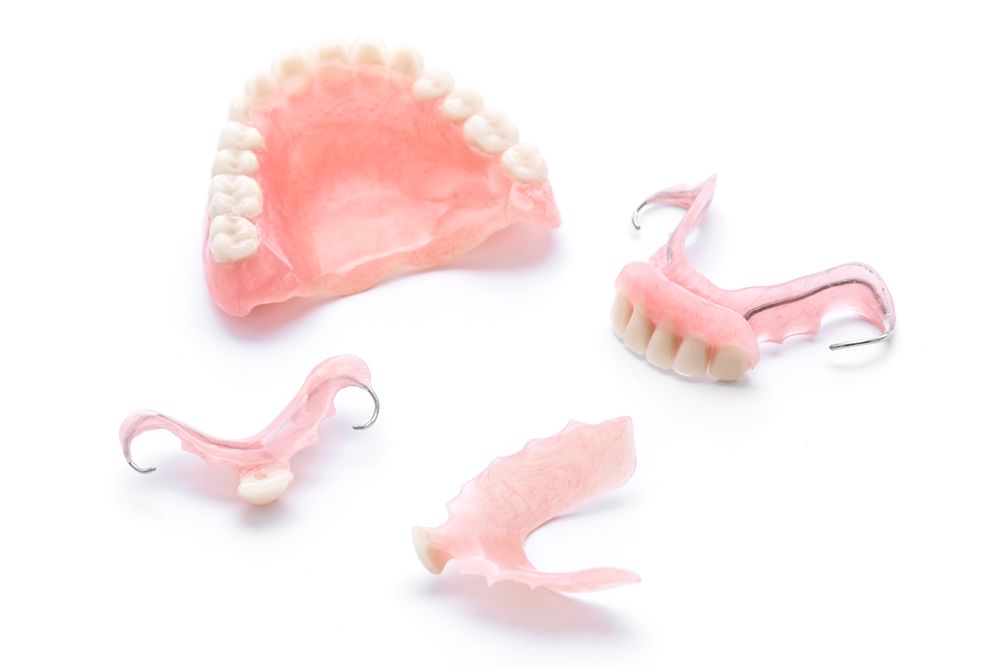Cast metal, acrylic and flexible are the most common types of partial dentures used to replace missing teeth. Cast metal partial dentures are the most frequently used because they are strong, durable, and can last for many years.
They are covered by plastic material that mimics the color of your gums, so they look natural in your mouth. Acrylic partial dentures are light and natural-looking but can be less durable than their metal counterparts. Flexible partial dentures are a newer option and are more comfortable to wear, but they are less durable and require more maintenance.
We will discuss the different types of partial dentures, their benefits and drawbacks, and how to choose the right one for you.
Cast Metal Partial Dentures
Cast metal partial dentures are a popular option when it comes to partials due to their strength and durability. Despite their metal frame, these partials are covered by gum-colored plastic, giving a natural and aesthetically pleasing appearance.
| What are cast metal partial dentures? Cast metal partial dentures are the most commonly used partial dentures because of their strength and durability. They consist of a rigid metal frame that is designed to fit around the remaining teeth and a plastic material that matches the color of your gums to cover the metal. How are they made? Advantages of cast metal partial dentures
Disadvantages of cast metal partial dentures
|

Credit: eurodenture.com
Acrylic Removable Partial Dentures
Acrylic removable partial dentures are one of the types of partial dentures that are commonly used for missing teeth. They are made of acrylic material that is lightweight and easy to wear, making them a comfortable option for those who need a partial denture.
| Acrylic Removable Partial Dentures |
| What are acrylic removable partial dentures? |
| Acrylic removable partial dentures are a type of dentures that are particularly designed to replace only a selected few missing teeth. These dentures are made from a combination of acrylic resin and metal. This type of denture is best suited for people who do not want to spend a lot of money on their dentures. |
| How are they made? |
| Acrylic removable partial dentures are made by taking an impression of the patient’s mouth, and then a model of their teeth is created. A metal framework is then created, which supports the acrylic teeth that are attached to it. This framework is then inserted into the mouth and is secured to the teeth on either side of the gap. |
| Advantages of acrylic removable partial dentures |
| Acrylic removable partial dentures are relatively cheap compared to other types of dentures. They are also easy to adjust if necessary. Furthermore, they are easy to clean and maintain. |
| Disadvantages of acrylic removable partial dentures |
| Acrylic removable partial dentures are not as durable as other types of dentures. They are susceptible to wear and tear over time and have a shorter lifespan compared to other types of dentures. Moreover, they can cause discomfort and soreness in the gums, especially in the initial stages after insertion. |
Flexible Partial Dentures
Flexible partial dentures are a type of removable partial denture used to replace one or more missing teeth. Unlike metal or acrylic partial dentures, flexible partials are made of a rubber-like material that bends and flexes with the natural movement of the mouth.
They are comfortable, lightweight, and virtually invisible.
There are different types of Partial Dentures available, including acrylic, metal, and flexible Partial Dentures. Flexible Partial Dentures are made of a flexible material, such as nylon, allowing for better comfort and fit. They are usually designed using a digital scanner and 3D printing, making the process faster and more precise. The advantages of flexible Partial Dentures include their aesthetic appeal, lightweight design, and improved comfort compared to metal dentures. However, they may not be as durable as other types of dentures, and they require proper maintenance to keep them in good condition. Overall, flexible Partial Dentures provide a viable alternative to traditional metal and acrylic options, especially for those looking for a more comfortable and aesthetic approach to tooth replacement.

Credit: www.cordovadental.com
Valplast Partial Dentures
When it comes to partial dentures, there are various types available, including acrylic, cast metal, and flexible dentures. Valplast partial dentures are a type of flexible denture made from a proprietary material that is thin, lightweight, and virtually unbreakable.
| Advantages | Disadvantages |
|---|---|
| – Comfortable | – More expensive than other types |
| – Aesthetic | – Limited to certain cases |
| – Non-invasive to teeth | – Not as sturdy as cast metal |
Valplast partial dentures are made from a digital CAD/CAM process, which ensures accuracy in fit and a high degree of customization. This process involves creating a digital model of the patient’s mouth and then using that model to fabricate the partial denture. The result is a denture that should fit comfortably and securely in the patient’s mouth.
Claspless Partial Dentures
Claspless partial dentures provide a more aesthetic option as they can be designed without any metal clasps showing while smiling. Instead, retention is achieved via precision attachments connected to adjacent teeth.
| What are claspless partial dentures? |
| Claspless partial dentures are a type of removable partial denture that do not have metal clasps. Instead, they use precision attachments that are often connected to the teeth adjacent to the missing tooth areas to provide retention and support. |
| How are they made? |
| Claspless partial dentures are typically made using advanced CAD/CAM technology and digital dentistry. The dentist will take impression of your mouth, and the laboratory will create the partial denture utilizing the latest technology for a precise fit. |
| Advantages of claspless partial dentures |
| The primary advantage of claspless partial dentures is that they are the most aesthetic partial denture option. They can be fabricated so that no metal will show while smiling, making them ideal for patients concerned about the appearance of their missing teeth. They are also generally comfortable to wear and easy to maintain. |
| Disadvantages of claspless partial dentures |
| The main disadvantage of claspless partial dentures is that they can be more expensive than other types of partial dentures. Additionally, they may require more frequent adjustments or repairs due to the precision attachments used for retention and support. |
How To Choose The Right Partial Dentures
There are several types of partial dentures to consider when choosing the right option for you. These options include acrylic, cast metal, and flexible dentures that can be custom-designed to fit comfortably and restore your smile. Consulting with your dentist can help you determine the best type of partial denture for your specific needs.
There are various types of partial dentures available to choose from. Factors to consider before choosing one include the location and number of missing teeth, the condition of adjacent teeth, cost, durability, and aesthetics. Consultation with a dentist is always recommended to ensure the best treatment plan is chosen. Comparing costs for each type of partial denture is also important as they can vary greatly. Common types of partial dentures include cast metal frameworks, acrylic flippers, and flexible dentures. Claspless partial dentures are also an option for those looking for a more aesthetic option. Valplast partial dentures, which are lightweight, comfortable, and virtually invisible, are another popular choice. Ultimately, the dentist can determine what type of partial denture is best suited for each individual case.

Credit: www.dentureliving.com
Frequently Asked Questions On Types Of Partial Dentures
What Is The Best Type Of Partial Dentures?
Cast metal partial dentures are considered the best type of partial dentures as they are strong and built to last many years. Although some patients may have concerns about metal, the rigid metal frame is covered by plastic that matches the color of your gums.
This makes them both functional and aesthetically pleasing.
What Is A Valplast Partial Denture?
A Valplast partial denture is a type of removable partial denture that is comfortable, lightweight, and metal-free. It is also highly aesthetic and virtually invisible, making it a great option for people who are missing natural teeth. Valplast partial dentures use a flexible material that conforms to the shape of the wearer’s mouth.
How Many Types Of Removable Partial Dentures Are There?
There are two common types of removable partial dentures – cast metal partial dentures and acrylic flippers. Flexible dentures are also an alternative option. Cast metal partial dentures are the most-used option as they are strong and can last for many years.
However, acrylic flippers are a cheaper option. Claspless partial dentures are the most aesthetic partial denture that can be fabricated so that no metal will show while smiling. Valplast® is also available to provide patients with comfortable, lightweight, and metal-free partial dentures, which are highly aesthetic and virtually invisible.
In brief, there are primarily four types of removable partial dentures – cast metal, acrylic flippers, flexible, and Valplast®.
Are There Partial Dentures Without Metal Clasps?
Yes, there are partial dentures without metal clasps. These dentures are also known as claspless partial dentures and get their retention from precision attachments that are often connected to the teeth adjacent to the missing tooth areas. The claspless partial denture is the most aesthetic and can be fabricated so that no metal will show while smiling.
Conclusion
Tooth loss can be a challenge, but thankfully, partial dentures can help to restore your smile to its former glory. There are many different types of partial dentures available, including acrylic, flexible, metal, and claspless options. The type of denture that’s right for you will depend on your specific needs and budget.
By working with your dentist and learning more about each option, you can find the perfect partial denture to get you smiling again in no time. So don’t let tooth loss hold you back any longer – explore your options today and get started on the path towards a healthier, happier smile!










